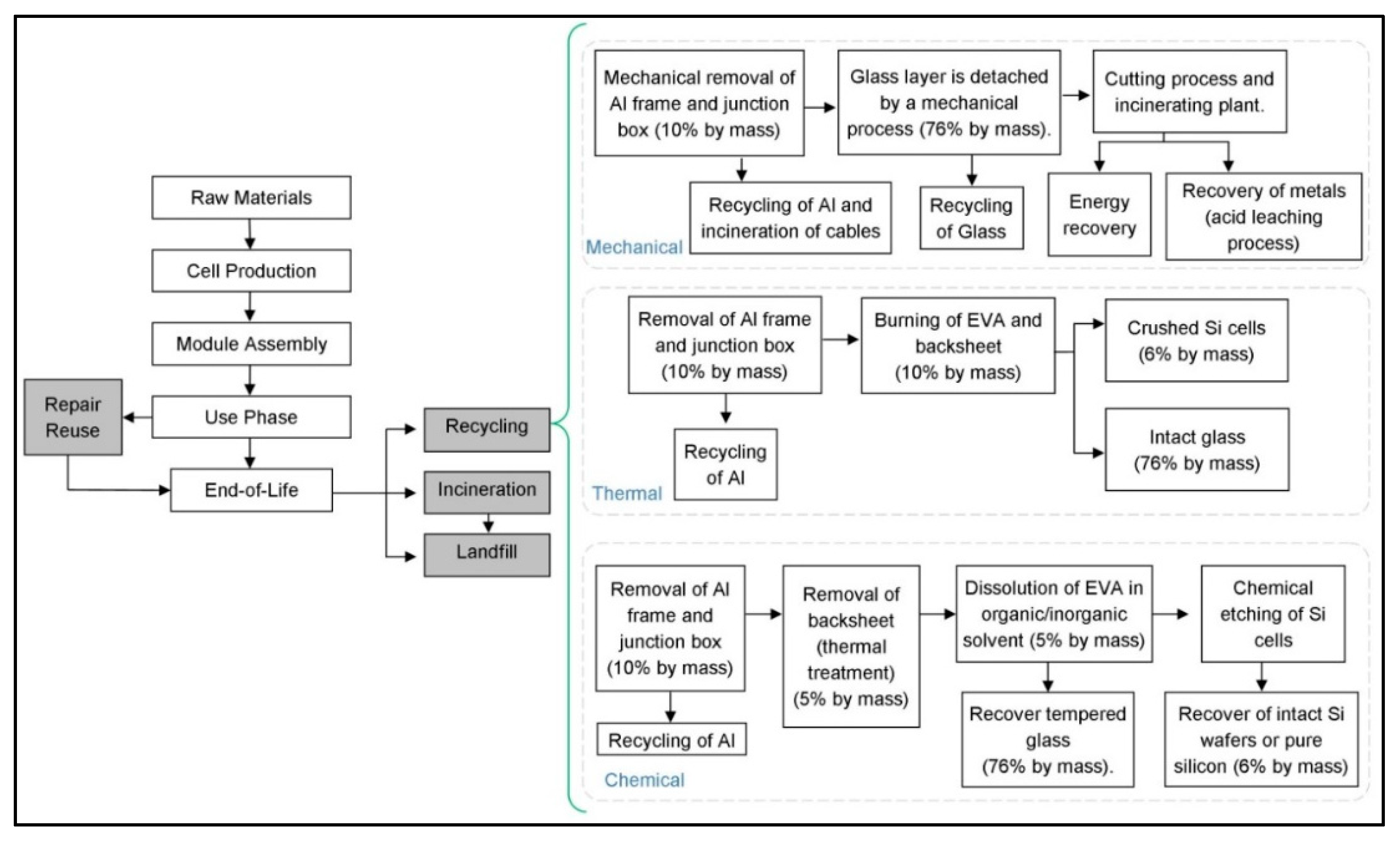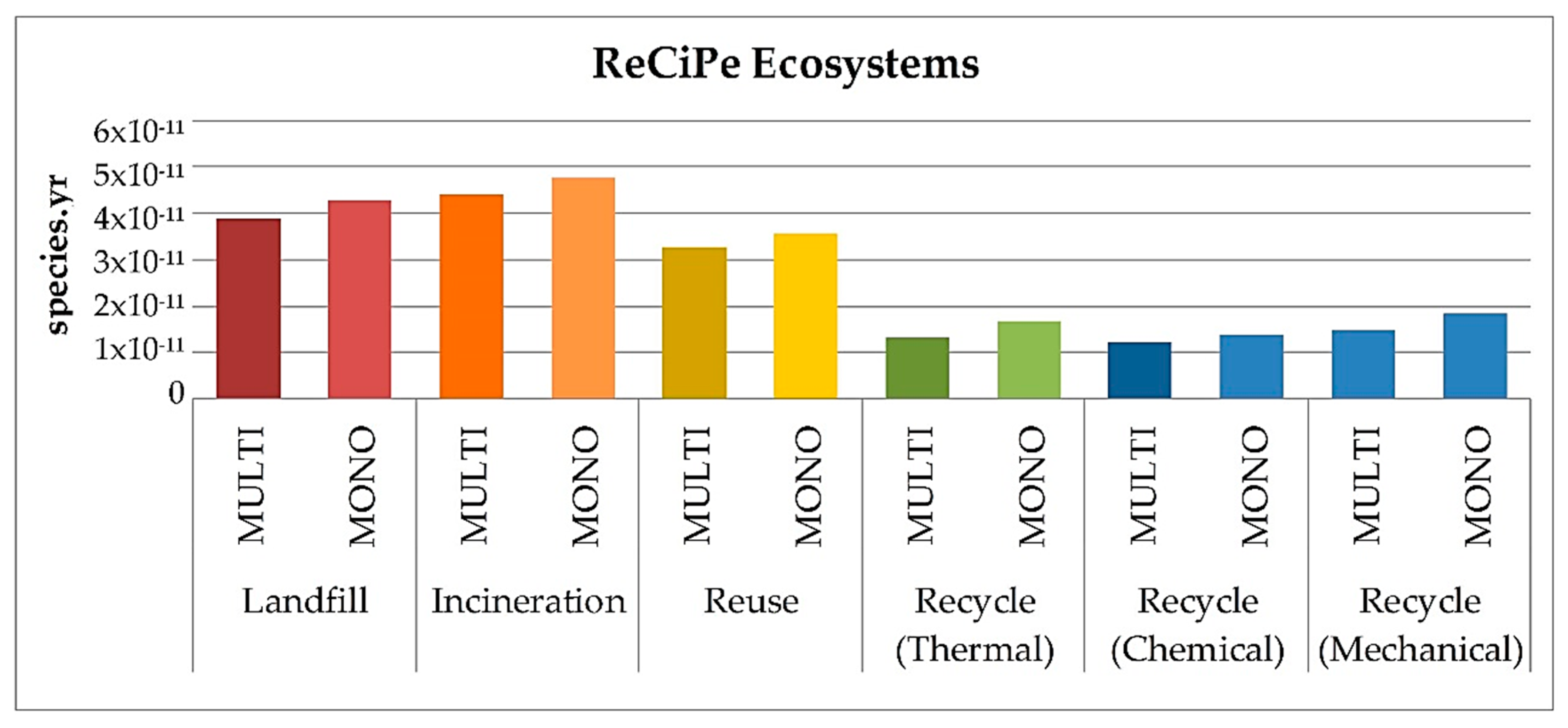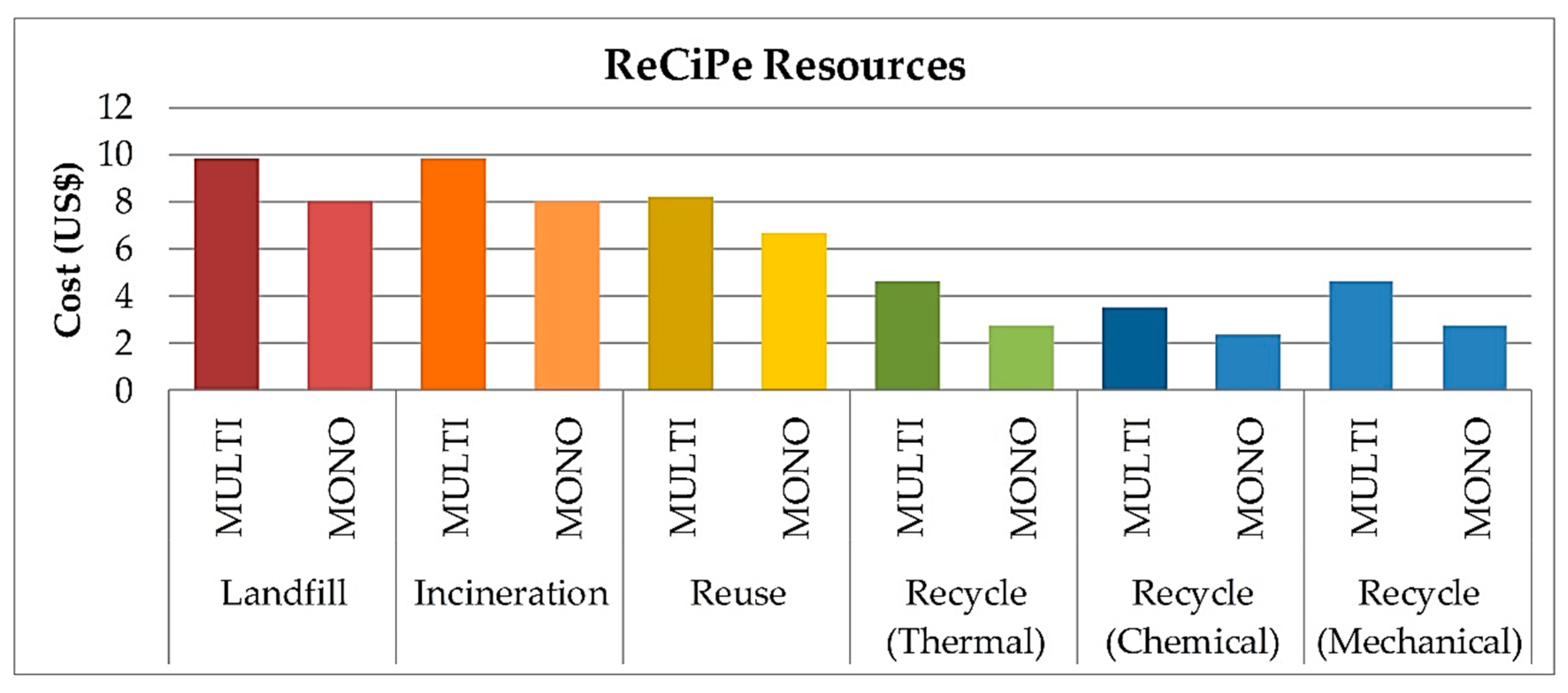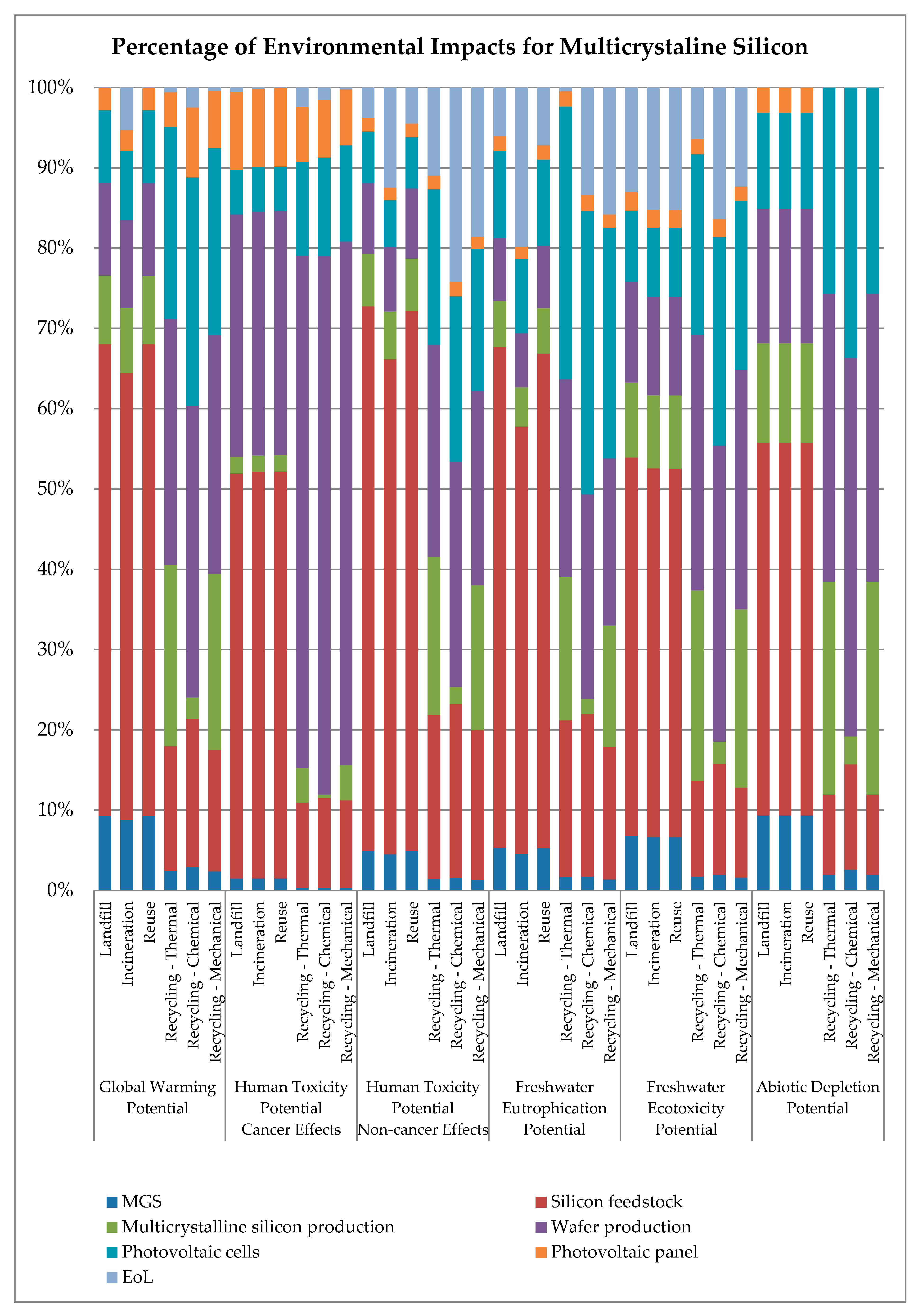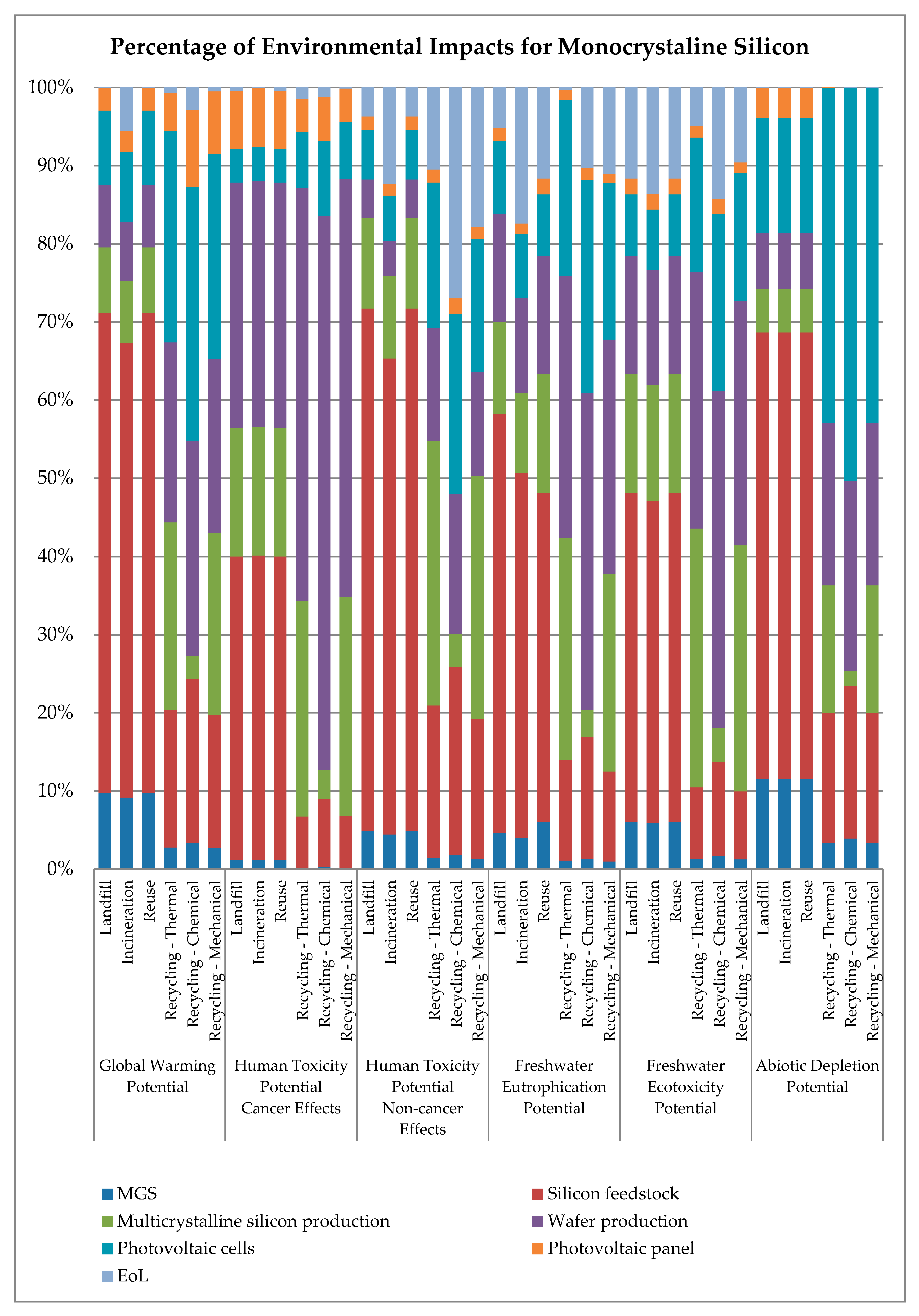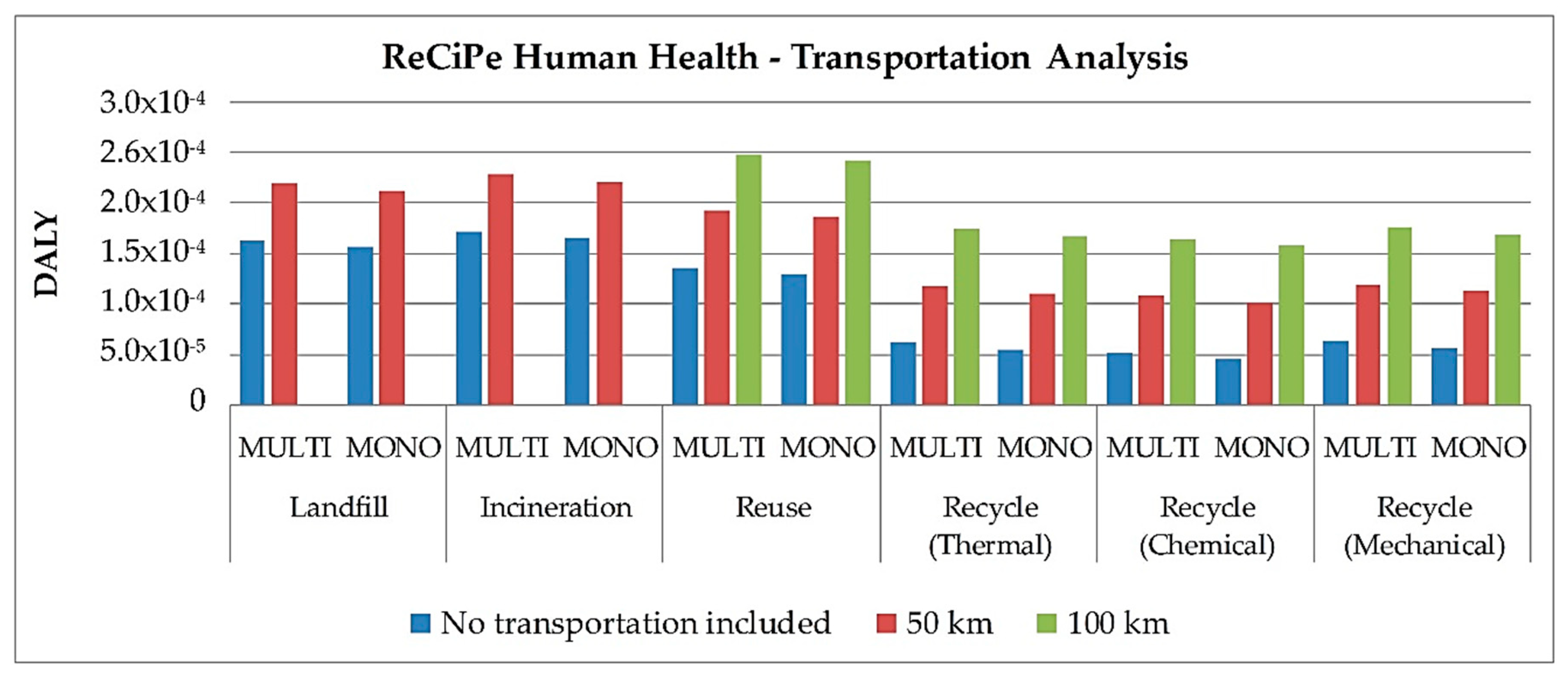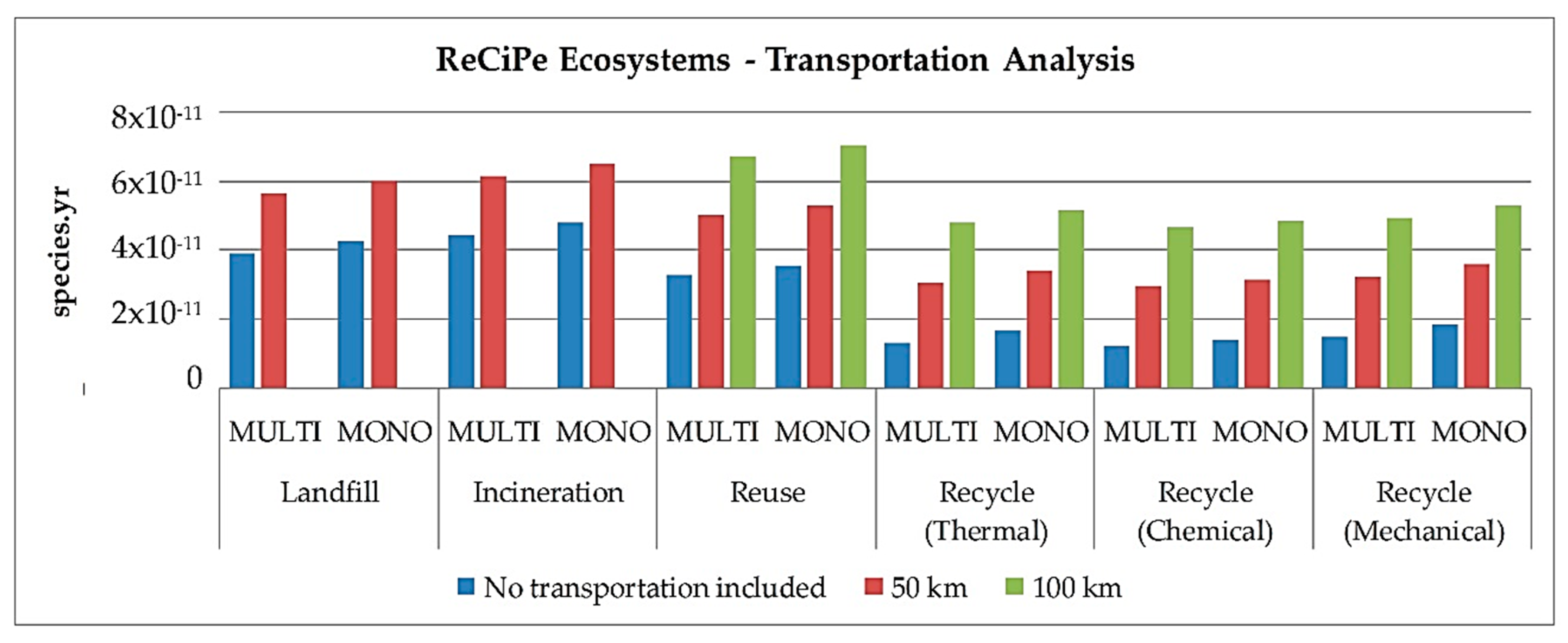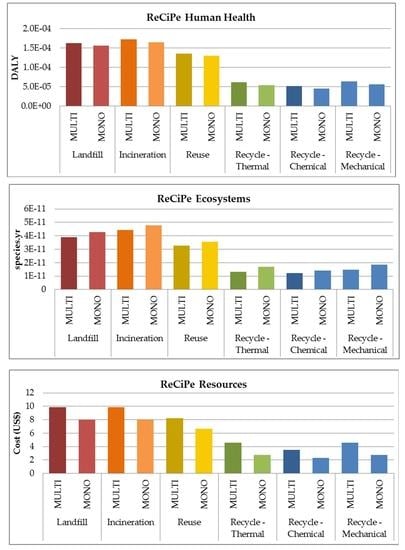1. Introduction
By the end of 2016, the world solar photovoltaic (PV) installed capacity was around 78 GW, which is more than double compared with 2014 and 32 times more than in 2000 [
1]. Because of this growth in the photovoltaic market, the cumulative global PV waste reached 250,000 tonnes by the end of 2016, while predictions show that, by 2050, the amount will increase to 5.5–6 million tonnes per year [
2]. The increasing waste from PV panels is an environmental obstacle to be overcome, but it also opens a range of opportunities to create processes that can transform this discarded material into an economic and ecological solution. For this to happen, there must be adequate end-of-life (EoL) management technologies and policies for PV systems and, particularly, PV modules [
2].
It is well known that today most of the PV modules go to landfill sites [
2], because PV recycling processes are not economically feasible yet and regulation in most countries has not been established for this waste stream [
2]. The late or non-inclusion of PV waste within countries’ waste legislation is usually related to the thus-far low quantities of EoL PV modules, due to their long lifetime (up to 25–30 years or more) [
3]. Regarding the financial aspects, the number of waste PV modules being taken to recycling facilities is currently small compared to the amount of other electronic wastes [
4], thus the technology developed for recycling PV waste is still unable to generate significant profits. Furthermore, the lack of a substantial body of knowledge on the potential environmental and economic impacts of c-Si PV waste treatments has not encouraged policymakers to get involved with this issue yet.
The majority of Life cycle assessment (LCA) studies of solar modules focus on the production and operation phases, with an emphasis on the energy requirements of these processes, which have been shown to have an important contribution to environmental impacts [
5]. Lately, there has been increasing interest and research on the impact of recycling processes of PV modules. Most of the studies in c-Si have focused on the impacts of a specific recycling process [
6,
7], while some of them compare recycling process with other scenarios such as landfill [
8] and incineration [
9]. This report compares the environmental impacts of landfill, incineration, reuse and three potential recycling options (mechanical, thermal and chemical routes) of EoL c-Si solar modules, considering results already described in the literature. Therefore, this paper aims to present an overview of options for PV waste management based on the environmental benefits or disadvantages produced by each EoL possibility. The results presented here can inform on the best route waste management to be taken from an ecological perspective, including the possible recovery of materials for their reuse during the initial steps of solar cells and modules production.
2. Materials and Methods
The LCA methodology quantifies the environmental impacts of a process or a product through a systematic set of procedures. This technique compiles and examines the inputs and outputs of materials and energy, which results in the quantification of the environmental impacts directly associated with the operation of processes or products throughout its life cycle [
10]. Results from an LCA can be used to inform the public sector, stakeholders and manufacturers about potential environmental impacts from products and processes and suggest possible improvements [
11].
The EoL of PV technologies is not commonly included in LCA studies due to the lack of information and data on the subject. However, there are a few studies, particularly for c-Si, that focus on the impacts of recycling processes for PV technologies [
6,
7] and some of them even compare these process with other scenarios such as landfill [
8] and incineration [
9]. Although the mentioned works are a step in the right direction, there is a need for a more comprehensive inventory of different recycling possibilities. For example, it is still challenging to understand the impacts of landfilling these devices and the possible benefits of recycling and recovering materials from used modules and cells. With this in mind, here we present an LCA to compare the effects of different EoL scenarios for c-Si solar modules, including recycling processes. The functional unit to be used in this analysis is defined as 1 kg of silicon-based PV waste modules.
This study assumed common c-Si PV module materials: silicon wafer cells with silver-based and aluminium contacts, ethylene vinyl acetate (EVA) encapsulant, aluminium frame, polymer (Tedlar
®) back-sheet, cover glass, tinned copper tabbing and lead-containing solder. The assessed impacts due to transportation of modules from their collection site to their EoL process (landfill, incineration or recycling plant) depend on a set of assumptions. It has been shown in a previous article [
7] that, for a recycling plant 400 km from the collection point, using a truck for transportation adds important environmental impacts to the recycling process, particularly, for abiotic depletion. However, the results were calculated for a specific transport and location. In this LCA, a separate analysis on the transportation phase is presented because the impacts do not depend on the recycling technology but on the collection system and distance. The assessment of the environmental impacts was performed using the LCA methodology (based on the ISO standard [
12]) with the aid of GaBi software, version 6 [
13]. The calculations are based on data collected from the literature and the Ecoinvent database, version 2 [
14]. For a better understanding of the LCA results, ReCiPe (2016) endpoint indicators are used for expressing the environmental impacts [
15].
2.1. EoL Options for c-Si Solar Modules
This LCA analysed four different EoL approaches for PV modules, as shown in
Figure 1. Each approach has particular characteristics and can offer a different improvement on the PV modules’ overall environmental impact.
2.1.1. Landfill
EoL PV modules can generate pollutants, especially the leaching of metals into the environment, if they are not correctly handled [
17,
18]. Unfortunately, the literature presents few experimental studies including the environmental consequences of landfilling c-Si PV modules, mostly focusing on the presence of lead and silver in the modules [
17,
19,
20]. However, studies analysing and predicting the future resource availability of materials (mostly metals) demonstrate the necessity of a proactive system approach to natural resources scarcity and consequential price increases [
21]. In most cases, before going to landfill, the PV module is separated from the balance-of-system (BOS), which allows the specific components to be separated, based in their waste types. The BOS refers to the non-module components of a PV system, including inverters, racking, cables/wires, switches, enclosures, fuses, ground fault detectors and other parts.
The BOS components are often neglected in PV LCA studies, but there are a few results for the impacts of these materials [
22,
23]. The BOS component impacts are predominantly carcinogens and ecotoxicity, attributable to the release of toxic substances and contaminants into the air or percolation into the ground during their manufacturing process and when they are placed in the landfill, affecting the water and the soil [
24].
2.1.2. Incineration
Incinerating solar modules, as for electronic waste in general, is harmful to the environment because of the release of toxic heavy metals, such as lead, into the atmosphere. Some of the materials contained in solar modules are known to be persistent and accumulative when released, which means long-term effects to humans, fauna and flora.
The benefit of this method is that EoL modules do not need to be separated from other commercial or industrial waste. On the other hand, this process abolishes the chances of recovering raw materials. The impacts of municipal waste incineration and subsequent disposal at a landfill for inert waste have already been assessed in the literature [
9], but the inventory was not made public.
2.1.3. Reuse
Reuse is also a popular choice in the waste management hierarchy and, for PV modules, this involves repair [
25]. The improvement of c-Si solar modules is feasible depending on the conditions of the materials. Typically, processes of repairing modules involve applying a new aluminium frame or replacing the junction box. It can also be a solution to replace diodes, plugs, sockets and more [
2]. Subsequently, the product receives a new label with new guarantees (in compliance with national laws).
The repaired module can have a new lifetime of approximately 15 years but with lower efficiency (around 1–2%) [
26,
27]. By lengthening their life, the industry avoids manufacture of replacement modules. The problem with this scenario is that, even with lower environmental outcomes due to the longer lifetime, the modules still have an EoL, hence not solving the problem completely but postponing the impacts.
2.1.4. Recycling
Different techniques for recycling solar modules are been developed for all PV technologies. Specifically, for c-Si, there are different possibilities for recycling and good results can be achieved with alternative or combined recycling processes. Generally, the first step is to mechanically remove the aluminium frame and the junction box from the rest of the module. The next stage is to delaminate or remove the encapsulant material, which is normally ethylene-vinyl-acetate (EVA). Several techniques can be used in this phase [
2], including thermal [
28,
29], and chemical (organic and inorganic) [
20,
30,
31] and mechanical recycling processes [
7].
The most common process for recycling c-Si modules, which is commercially available in Europe [
32], is based on a mechanical process for the extraction of the remaining materials of the module. However, the maximum amount of recovered materials from this process is currently about 80%, which is insufficient for future regulation requirements [
33] and the value of the recovered resources is lower than that of the original raw materials [
32]. Recently. the European company PV Cycle has achieved a recycling rate of 96% for c-Si PV modules using a new process that combines mechanical and thermal treatments [
34].
During the thermal process, the EVA and backsheet (Tedlar
®) layers are burned, releasing potentially noxious and harmful emissions into the air. Therefore, in this study, we considered the treatment of the exhaust gas, as it is essential in the pursuit of an environmentally responsible process [
28,
29]. The same assumption was made for the chemical process, as we considered that the backsheet is removed from the module after the chemical treatment. Assuming Tedlar
® as the backsheet, it is demonstrated that it has a good thermal stability in the range of approximately −70–100 °C and loses its strength at 260–300 °C, which is not hot enough for the EVA to start to decompose and so the Tedlar can be separated first from EVA [
28], however more experiments need to be done related to this temperature.
2.2. Process Descriptions and Inventory Data
Figure 2 shows a process flow diagram for c-Si possible EoL scenarios and the description of each process. The process steps represented in
Figure 2 are a compilation of the best results found by the authors and are explained in this session.
Life Cycle Inventories (LCI) are essential for LCA studies, and the availability of such data is frequently the greatest obstacle to conduct an LCA. However, since several authors published the environmental impacts from the production process of c-Si solar cells and modules, the inventory for these processes is well known. The International Energy Agency (IEA), through Task 12 of the Photovoltaic Power Systems Programme, published a report in 2015 containing a complete inventory for mono- and multi-crystalline silicon solar cells and modules production, including (limited) data for the BOS, as well as environmental impacts from these technologies [
5].
As
Figure 2 shows, the c-Si solar module production process starts with the raw materials (quartz sand), for which we included mining, processing and purification stages. The encapsulation materials (e.g., silica for glass) were also considered in this step. The cell production includes mono- or multi-crystalline silicon ingots sliced into wafers, p-n junction formation and application and firing of metallization pastes. In the module manufacturing stage, cells are connected physically and electrically and, after that, encapsulated by glass and plastics, which, together with the BOS components, create a PV system. The use phase includes the PV system installation, operation and maintenance. The BOS components and use phase impacts were not considered in this study. The BOS impacts calculated by other authors demonstrate that these materials have significant impacts [
22,
23], but the inventory is still very limited. The use phase has not demonstrated significant impacts [
35], so it can be neglected. When the modules reach their EoL, different pathways can be taken, as discussed above.
The impacts from the landfill, incineration and reuse scenarios are not completely studied yet, but the Ecoinvent database [
36] has a comprehensive database for plastic and some specific metals, shown in the
Supplementary Material.
For the recycling scenario, the considered processes were thermal [
28,
29] and chemical [
6,
20,
30,
31] methods, compared with the mechanical approach, which is already published [
7] but excluding the transportation impacts from all processes. These recycling processes start with the mechanical separation of the junction box and aluminium frame, which can be recycled and reused. We did not consider the aluminium frame, the cables and the plastic parts in our recycling processes because they are normally sent to separate plants for further treatment [
7].
The thermal process inventory is based on the controlled burning of EVA (400–500 °C), assuming the glass can be recovered without breaking and could be directly used again as the module component [
28,
29]. In this process, it is expected that most of the cells end up breaking due to the excessive pressure from the gasses released during the burning process [
28], but it can be reused as raw material for ingot growing (we assumed that 100% of the raw silicon is from this recycling process). There is also a 100% recovery of silver from the solar cells [
28]. Tests with thermal treatment under air resulted in significant temperature increase and the carbonisation of the EVA. The absence of oxygen during this process avoids the oxidation of some materials, so a nitrogen atmosphere, which prevents chemical oxidation of the EVA layer [
19,
37], was assumed.
The chemical route assumed in this study starts with melting the EVA layer by a thermal process as already explained [
28]. The most promising organic solvents used for this reaction are tetrahydrofuran, o-dichlorobenzene and toluene. Toluene is the cheapest and more stable among these options and, therefore, is the most common chemical used for dissolving EVA and it is our assumption in this report. The assumption was that this process is carried out at 80 °C, as that was proven to be more effective compared with room temperature [
30]. After this step, the glass is completely recovered and directly used again as a module component. In the next stage, it is possible to recover the Si from the cells by using a combination of chemicals. Subsequently, potassium hydroxide is used to remove Al metal coatings, and a mixture of nitric acid, hydrogen fluoride and acetic acid remove metals, anti-reflection coatings and p-n junctions. The metals (including silicon) were assumed to be reused in new cells [
6] and 80% of the silicon used in new cells can come from this recycling process.
For the mechanical approach, the Full Recovery End of Life Photovoltaic (FRELP) process was used for the calculations. This project aims to test and develop innovative technologies for 100% recycling of EoL PV modules in an economically viable way [
38]. The impacts of this process are calculated based on the published “gate-to-gate” LCA that assesses the potential environmental impacts related to the FRELP recycling process [
7], excluding the impacts from transportation.
The production processes for mono- and multi-crystalline silicon solar modules are well known, and their inventories are public [
5]. The
Supplementary Materials present the inventories for the recycling processes. For all cases, the analysis of the influence of transportation is discussed independently using estimated distances for each of the EoL scenarios.
3. Results and Discussion
Based on the LCA methodology and the processes described, the results for global warming (GWP), human toxicity–cancer and non-cancer effects (HTP-CE and HTP-nCE), freshwater eutrophication (FEuP), freshwater ecotoxicity (FEcP) and abiotic depletion of elements potential (ADP) impacts are presented in this report. The calculations are based on the available data of each EoL scenario, but, as already mentioned, these processes are not deeply understood, and their inventories are still incomplete. Thus, estimations were made for the missing data based on published experiments and industrial processes. The results presented in this report are not completely representative of the environmental effects of the process and should be used with caution.
A summary of all results was calculated using the ReCiPe method, which is recent and harmonises the environmental impacts based on current data [
15]. This method’s primary objective is to transform all life cycle inventory results, into a limited number of indicator scores. These indicator scores express the relative severity on an environmental impact category and are presented in three categories, i.e., the effect on human health (
Figure 3), ecosystems (
Figure 4) and resources (
Figure 5). This approach is usually beneficial to aid the understanding of environmental outcomes if the target audience is not formed of experts in this field.
The comparison of all scenarios studied, presented by the ReCiPe indicators, shows that lower environmental impacts can be achieved through recycling methods. That result is mainly due to the recycling and reuse of part of the raw materials (e.g., silicon and silver) and the glass and aluminium from the frame, which confirms the importance of high-value recycling processes compared to other disposal solutions that cannot reuse or recycle the individual components.
It can also be observed that the incineration process produces the worst impacts compared with the other EoL scenarios, mainly because this process uses more primary energy than the other methods presented in this LCA. It is important to highlight that this analysis did not consider any thermal energy or electricity produced by the incineration process, thus no energetic benefit is measured in this scenario.
The chemical approach shows low impacts. However, the use of toxic chemicals should always be observed in any environmental analysis. The reuse of the solvent (in this case, toluene) in multiple processes is possible and should be considered, as well as the final treatment when the chemical cannot be used again to recycle new PV modules.
From the analysis in
Figure 3,
Figure 4 and
Figure 5, it can also be observed that reuse seems to be a better option compared to the landfill and the incineration scenarios. In addition, besides reducing impacts, the extra lifetime considered in the reuse scenario also allows more time for recycling technologies to be developed. Besides, the repaired PV modules can be alternatively resold as used panels at a reduced market price of approximately 70% of the original sales price [
2], which creates a good opportunity for a significant secondary market for used PV modules.
The impacts from the recovery of metals from the bottom ash are significant for freshwater eutrophication and acidification, among other impacts that were not calculated in the present LCA. These impacts are mainly due to the processes of sieving, acid leaching, electrolysis, and acid neutralisation.
Considering a more specific analysis (
Figure 6 and
Figure 7), the GWP impacts are mostly produced by the silicon feedstock, which includes 50% solar grade silicon (SGS) and 50% electronic grade silicon (EGS), due to the high energy requirement for these processes [
5]. Both recycling processes can recover the silicon and reuse it. The thermal treatment can recover crushed silicon cells and reprocess them by ingot growth. The possibility of reusing silicon as raw material or intact wafers to produce new silicon solar cells is beneficial regarding environmental outcomes from the entire process. The recovery of the glass sheet is also advantageous, mostly for the ADP, as this material represents a high percentage of the total weight of the module (approximately 80%) [
2].
It is evident that the overall results from the recycling processes are environmentally favourable when compared with the other scenarios included in this study, but some additional aspects should be considered. The ADP impacts for the recycling processes (
Supplementary Material) show that the cell production has higher consequences compared to the other EoL scenarios, mainly because, in this study, we did not considered the recovery of other materials besides glass, silver, aluminium and silicon. Lower environmental impacts may be achieved with more complex recycling methods that can recover additional materials and reuse them in new solar cells and modules. The European directive about electronic waste management, which includes PV modules, highlights the importance of recycling potentially harmful substances and rare materials as an environmental solution [
33].
Additionally, the substances used during the chemical recycling treatment studied (tetrahydrofuran, o-dichlorobenzene and toluene) present serious issues related to human health and can be risky for fauna and flora. Tetrahydrofuran is a carcinogen and when in contact with humans or animals, can cause severe diseases and even death. This substance is mobile in the environment causing contamination of water, soil and air [
39]. The o-dichlorobenzene is not carcinogenic but, otherwise, has the same environmental and health effects [
40]. Toluene is also toxic for both humans and animals for acute (short-term) and chronic (long-term) exposures. It can cause several illnesses, but there is inadequate information to assess the carcinogenic potential of this substance. It is an environmentally hazardous material that can affect soil and water causing long-lasting effects in aquatic organisms [
41].
Analysis of Transportation Impacts
As discussed previously, transportation can add important impacts to these possible EoL scenarios [
7], but it depends entirely on the location of the EoL modules and their final destination. These impacts can be negligible if the sites for the collection of the PV panels, treatment and disposal are assumed to be in the same area, but, in most cases, the data for transport mode and distance are difficult to assess for the general case [
2].
For example, significant impacts related to the transport of PV waste to the recycling site were calculated for the FRELP process [
7]. However, such result applies only to that particular case study; hence, the approach chosen in this study is more general. As the location of the EoL treatment plant was not set in this study,
Figure 8,
Figure 9 and
Figure 10 show the results of three scenarios: no transport and a distance of 50 km and 100 km to the EoL treatment facility. It is expected that, for the EoI scenarios of landfill and incineration, a maximum distance of 50 km is adequate as these sites are ubiquitous within economic centres. However, a distance of 100 km might be more adequate to represent the travel required to PV recycling centres as these centres are not found regularly. In any case, the information presented below can be scaled to any distance required. For this analysis, only terrestrial transportation (Ecoinvent inventory for “lorry 16–32 t”) was considered.
The inclusion of transportation increases the overall results for all three ReCiPe environmental categories in an important way, sometimes doubling or tripling the impacts for the recycling EoL scenarios, which is in line with previous study [
7]. It is important to highlight that the impacts from the transportation depend not only on the distance from the collection point to the EoL treatment facility, but also on the transportation method.
The analysis in
Figure 8 and
Figure 9 shows that a PV recycling plant needs to be at most 80 km further away than the EoL scenarios of landfill and incineration for recycling to have lower impacts, when considering human health and ecosystems.
Figure 10 shows that the impacts related to ReCiPe resources is strongly influenced by the transportation process in all EoL scenarios analysed. In this case, for the distance of 100 km, the recycling processes are still better environmental options compared with some other choices. However, these results seem to show that it will be important to develop either portable recycling plants or distributed recycling plants that can be located reasonably close to the places where modules reach EoL.
4. Conclusions
The present study discussed different scenarios for the EoL of c-Si solar modules through the LCA methodology. It analysed the environmental impacts of each scenario based on the GWP, HTP-CE, HTP-nCE, FEuP, FEcP and ADP of the whole process of manufacturing c-Si solar modules (considering mono- and multi-crystalline silicon solar cells) from the raw materials until the EoL. The possible EoL scenarios considered were landfill, incineration, reuse and recycling (considering mechanical, thermal and chemical methods).
The results validate the environmental benefits of the recycling processes when compared with other possible scenarios for all categories. With the assumptions made in this LCA, all recycling processes produce improved environmental outcomes. The main reason for that is that these processes can recover glass and silicon to be reused to manufacture new solar cells and modules.
In this study, the recovery of other materials besides glass, aluminium and silicon was not considered. Hence, the cell production, particularly, presents higher ADP impacts from the recycling processes compared to the other EoL scenarios. This outcome could be lower with the adoption of more complex recycling processes that can recycle other substances, such as lead and silver. Especially for thermal recycling, the combination of other processes after the recovery of the glass needs to be addressed. Studies show that the combination of thermal and chemical methods can achieve good recycling rates and recover almost all materials from solar modules [
7,
9,
42].
Another critical concern is the use of toxic substances during the chemical recycling treatment, which must be addressed. In this LCA, we considered tetrahydrofuran, o-dichlorobenzene and toluene, which show the most promising results. However, these substances present serious issues related to human health, fauna and flora. Alternative chemicals should be tested to decrease possibilities of environmental impacts associated with chemical routes for recycling solar modules.
Transportation can add significant environmental impacts to all scenarios analysed. In this LCA, the maximum distance from the collection point to the treatment facility for the recycling methods to have lower environmental impacts than the other options studied was shown. For example, for recycling to be the best option, it must be no more than 80 km further away than a landfill or incineration plant when considering human health and ecosystems impacts (ReCiPe) and using a diesel truck as the transportation method. The impacts for resources depletion (ReCiPe) are also heavily impacted by the transportation method and, in this case, a distance of 100 km still shows the recycling processes as the best environmental option.
In summary, the key finding of this study is that the possibility of recycling materials from solar modules can result in lower environmental impacts when compared with other EoL scenarios, i.e., landfill, incineration and reuse, based on the assumptions made in this LCA, but attention should be given to the transportation for all cases. Small fixed or portable recycling facilities could be considered, as could less damaging transport modes than road trucks. Attention should also be given to reducing the use of toxic substances during the chemical routes for recycling.

